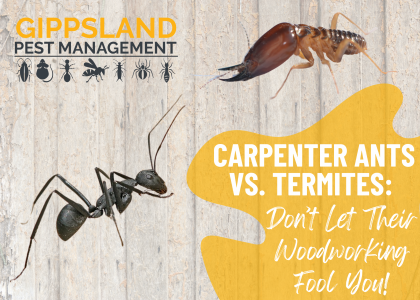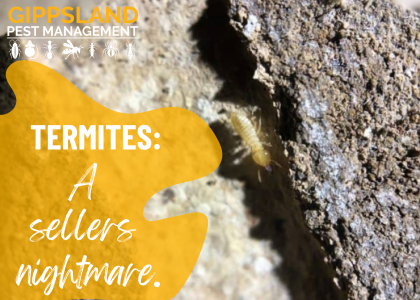Gippsland Pest Management offers a free quote to come out and assess your property for a termite treatment. Generally treatments range between $1,500 – $5,000 in extreme circumstances. As all houses are different the pricing can vary greatly. Once our technician has done an assessment we will provide an accurate quote in writing for your records.
Termite Management
About Termites
There are many different species of termites. The most common species in Victoria is Coptotermes. This species is responsible for more than 80% of the termite damage caused to buildings.
Coptotermes build nests in trees, favouring eucalypts, stumps, under concrete flooring, in wall cavities, or enclosed verandas. These termites usually travel at least 50m from the colony in search of food via a series of underground tunnels.
Areas Termites Damage
Termite nests and tunnels are kept moist as the worker termites cannot stand low humidity for very long. Therefore an ideal nest site has access to water as well as wood and soil. Termites tend to damage areas of the home that have exposure to water such as bathrooms, kitchens and laundries.
This is not always the case sometimes the first signs of damage are limited to architraves and door frames. Regardless of which areas of your home are damaged repair costs do tend to add up, even if you do the repairs yourself as an owner/builder. We have heard of circumstances where clients have had a $15,000 bill to replace their bathroom after termite damage.
Reducing the Risk of Termites
Gippsland Pest Management advises that a full termite management program involves yearly inspections and reapplication of the termiticide chemicals every 7 years. However there are some steps homeowners can take to reduce the risk of termites entering their home.
These include:
- Ensuring the soil does not cover the slab edge of the home as this allows for inspection zones and ensures that susceptible building timbers aren’t in contact with the soil which can cause a breach or bridging affect allowing Termites easy access to the home.
- Ensuring subfloors are well ventilated and remain dry.
- Using only resistant timbers below floor level, this means, that have been chemically treated such as treated pine.
- Avoiding storage of wood directly on the soil, under, around or in contact with buildings, for many gardeners this is difficult but using naturally resistant timber such as red gum and white cypress pine to form your garden edges instead of railway sleepers is a good compromise. Otherwise, Gippsland Pest Management can come out and treat your railway sleepers for termites instead.
- Improving drainage and fixing the leaky plumbing in order to reduce available soil moisture.




